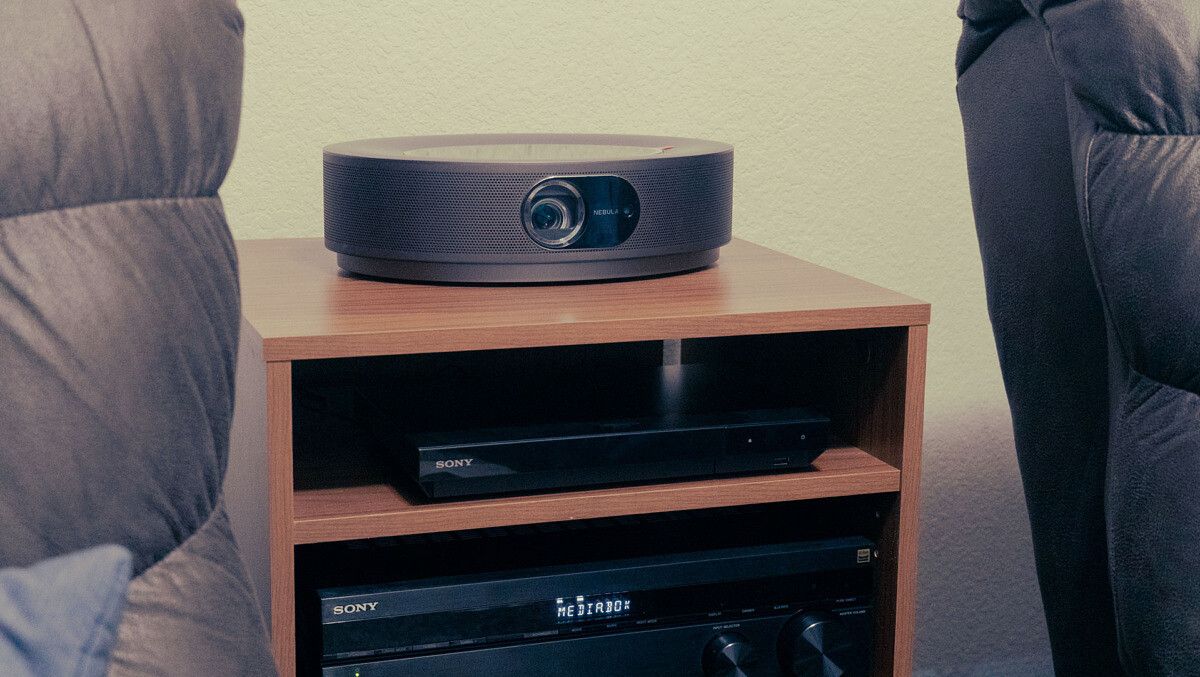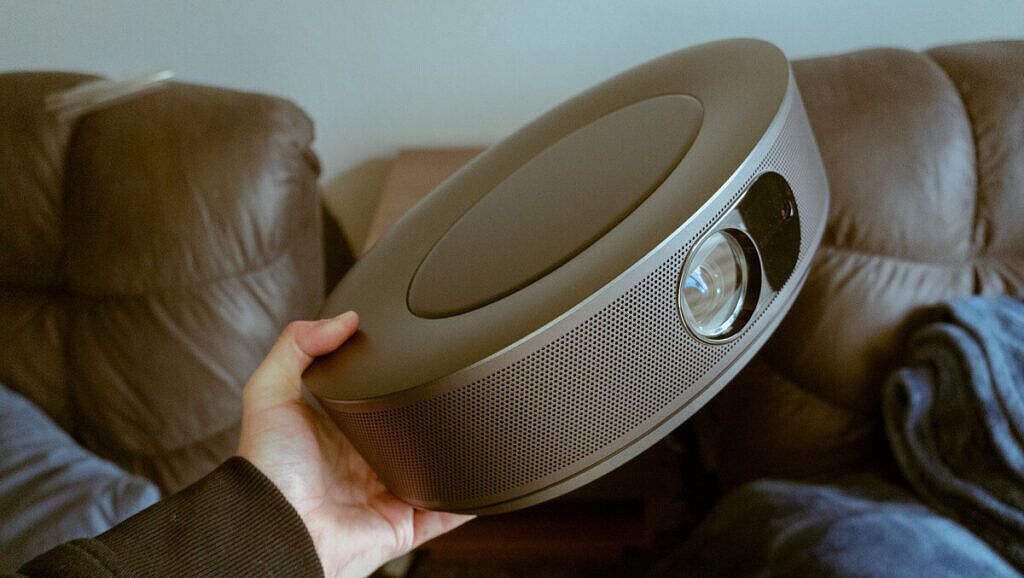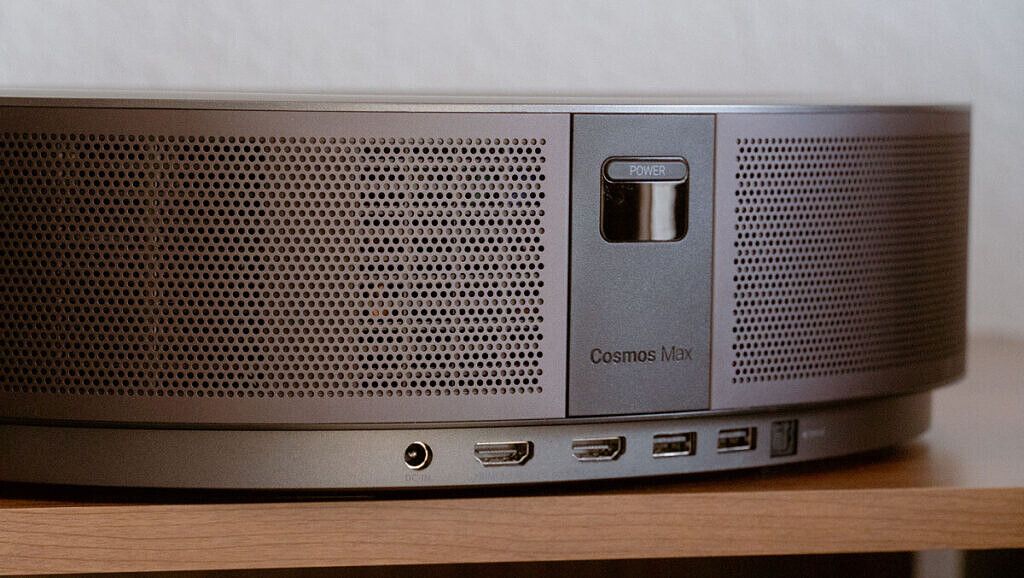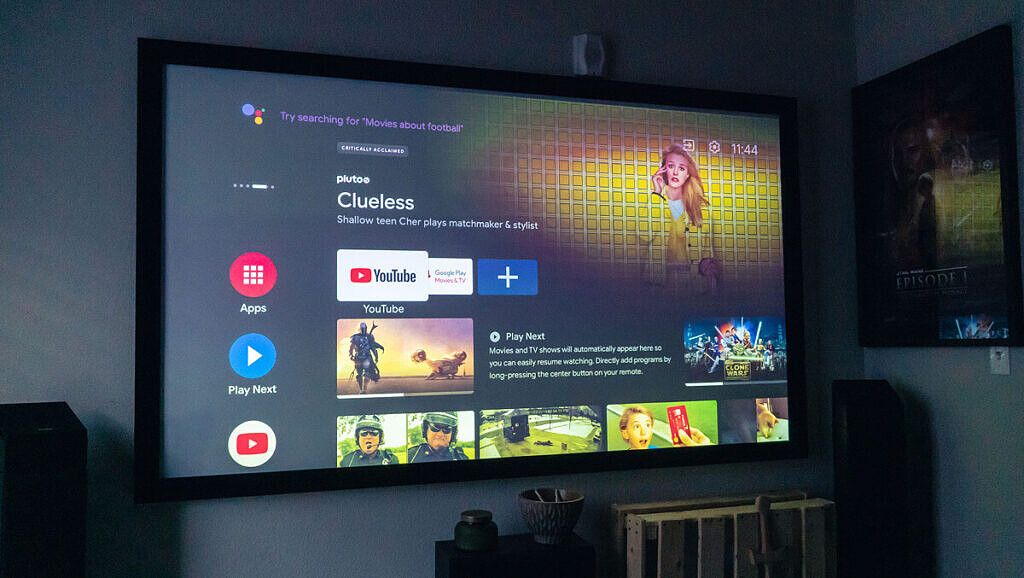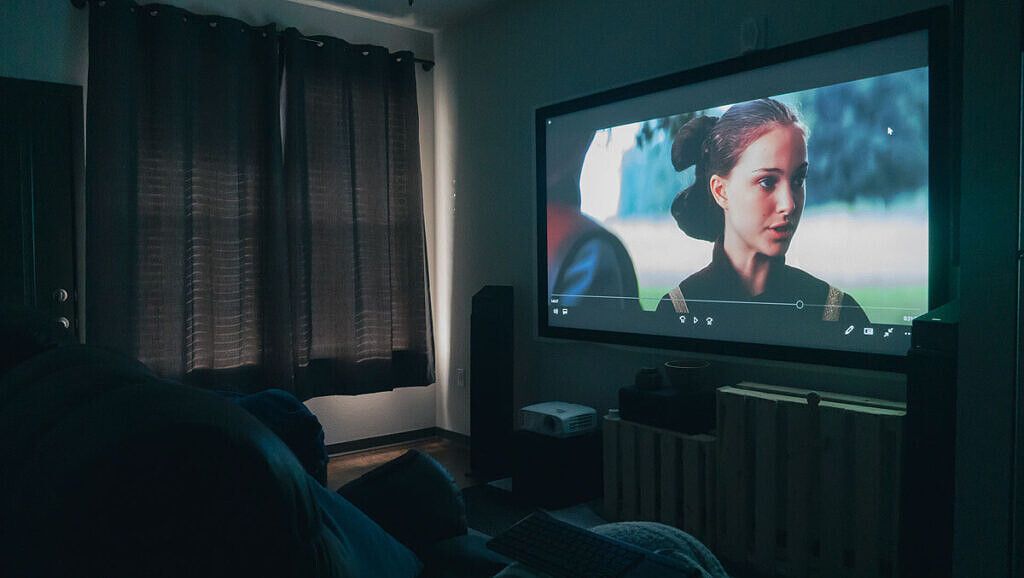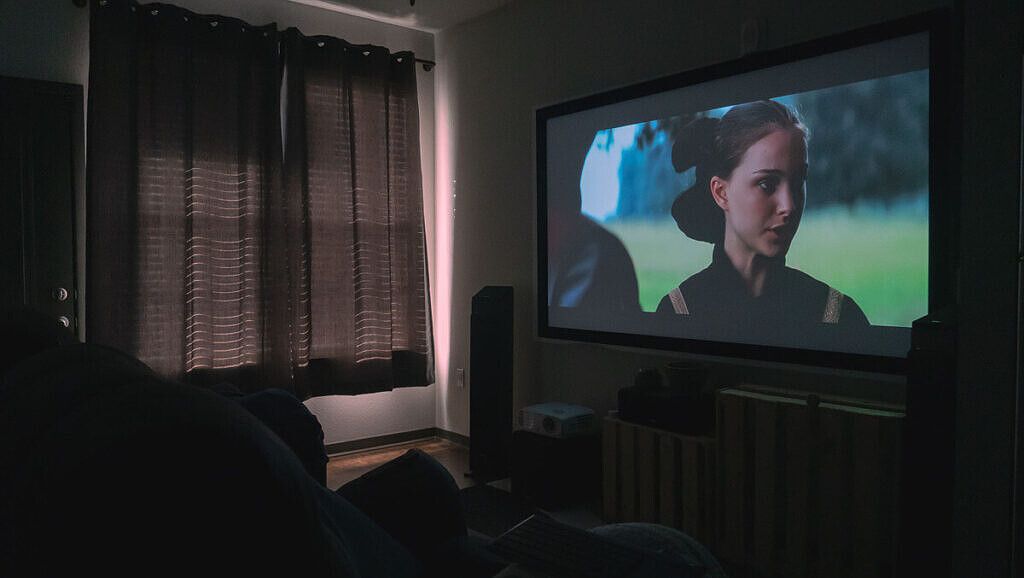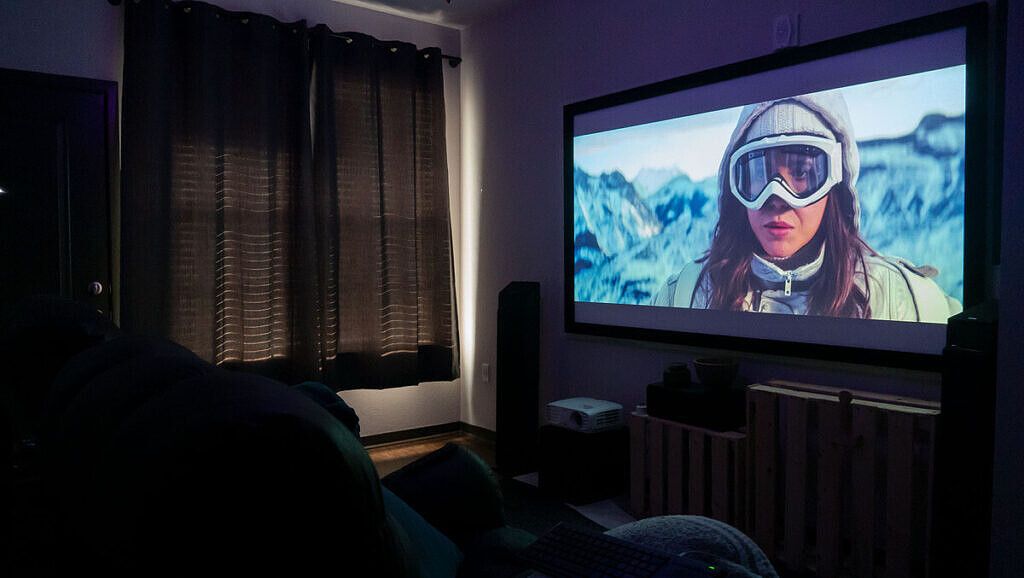The company Anker has been making entry-level home theater projectors for a while. Their projectors focus on being simple, portable, and high quality. The Nebula Cosmos Max is their most ambitious projector by far. This 4K HDR projector is equipped with Google TV and has some of the latest projector technology. Coming in at $1,699.99, this projector will be competing with other 4K solutions in this price range. So let's take a look and see the strengths and weaknesses of the Nebula Cosmos Max.
Prepare for the ultimate Super Bowl viewing experience with the Nebula Cosmos Max. Get in the Game!
Click to save 10% on all Nebula products and enter a $1000 prize draw.
The Nebula Cosmos Max is the best way to experience your favorite sports programs. For the same price as a TV, you can experience the game on a massive 150" screen, in a very impressive 4K HDR image. The Dolby Digital Plus speakers let you hear every detail with sound that fills the entire room. Use Google TV to access apps like ESPN so you can stream content right to your projector, without the need for any additional hardware. These things make the Nebula Cosmos Max a really great solution for anyone who loves to watch sports and want to upgrade their experience.
So continue reading for our full review of the Nebula Cosmos Max, if you're interested in making the jump to a projector system.
Build and Design
Most projectors put very little effort into looking nice. That's because home theater enthusiasts tend to tuck their projector away where it can't be seen. Since the Nebula Cosmos Max is more of a portable projector, this will often be placed on a coffee table or somewhere else where it's seen. Because of this, the projector has a very nice design. A symmetrical oval shape has the lens centered in the middle of the projector, with speaker grills surrounding the edge. Even the ports are placed directly centered in the back.
On the bottom of the projector, you'll find a tripod mount for easy setup. The top of the machine shows a backlit field of stars, with the Nebula logo in the center. The stars and the logo can be toggled on and off in the Google TV settings, so you can choose to have just the stars, just the logo, both, or neither.
The remote has basic navigation buttons, an auto-focus button, and a dedicated Google Assistant button. Unfortunately the remote is not backlit, which will have you using your phone as a flashlight to see what you're pressing. Because of the simple layout, you'll memorize the buttons over time, but that will be a bit of an annoyance at first.
Connectivity
The Nebula Cosmos Max is designed to be an all-in-one portable experience. Achieving this type of portability requires a simplified connected system. The Google TV OS allows you to leave the AV receiver, Bluray player, or media box behind. You can use this smart projector to stream your movies or shows, using any of the many streaming services on Google TV. This includes services like Netflix and Hulu. But you should also consider ESPN for sports, which is the ultimate way to watch the upcoming Super Bowl.
Of course, with Google TV you have built-in WiFi and Bluetooth. You'll be able to connect to a network, and pair controllers or remotes without needing to use extra cables. This adds to the portability of this projector. With all of these built-in features, you're ready to watch something with your friends, and you only need a single power cord. This is the ultimate all-in-one solution.
Google TV will be running on the Cosmos' internal hardware which consists of 2GB of RAM and 12GB of storage. The system is fairly fast, but you will notice it freeze up every once in a while. The internal storage will fill up pretty quickly, with a little over 9GB of useable storage. I recommend adding a USB drive with one of the available ports, if you plan on adding many apps or downloading movies.
Now even though the projector is able to be used completely independently from other equipment, that doesn't mean that it doesn't come with all of the ports needed to integrate it into your home theater setup. In fact, the Nebula Cosmos Max includes two HDMI ports, two USB ports, and one optical port. These ports are easily accessible along the back of the projector.
I was able to put this projector in my home theater to play Blurays and use my 5.1.2 speaker setup. You can connect this projector to an AV receiver via HDMI, and you can use the USB ports to add controllers, mouse/keyboard, microphones, or external drives. A great way to take advantage of the USB ports is to preload some movies or shows onto a USB drive, before bringing your projector to a movie night. This also eliminates the need for any sort of internet connection, while still being able to use Google TV to watch a movie.
Audio
Projectors are not known for having good built-in audio quality. In fact, they're usually pretty terrible. This is not the case with the Nebula Cosmos Max. This projector has four 10W speakers that are dedicated to providing a Dolby Digital Plus audio experience. These are designed to deliver 360 degrees of audio for you and your friends, while you enjoy your movies.
The audio quality is good enough that you can still enjoy watching a movie, without using external speakers. The four dedicated speakers let the projector fill the entire room with high-quality audio, for an immersive and exciting viewing experience. This effect especially comes into play when watching sports. The separation of dialogue and other sounds is important for making sure you don't miss anything being said.
So while the sound quality is immensely better than the standard internal projector speakers, don't expect this to offer a true home theater audio experience. It's vastly better than other internal speakers, but it's not designed to replace a true surround sound system. The projector can even double as Bluetooth speakers by turning on Bluetooth speaker mode. This mode allows you to use the great internal speakers to play music from your phone. This is a cool feature that makes the most out of these high-quality speakers.
Display
Resolution, Size, and Startup time
The strongest aspect of this projector is the fact that it has a 4K resolution (3840 x 2160p). To achieve this resolution, the projector uses upscaling technology, which is typical of any other projector in this price range. It's equipped with a 0.47” 4K UHD DMD chip which has a native resolution of 1920×1080p. The upscaled result is very impressive. Watching 4K movies on this projector looks noticeably better than other 4K projectors that I used for comparison.
The display has the ability to go up to 150" with a throw ratio of 1.2:1. This will satisfy casual users as well as home theater enthusiasts. Adjusting your projector display to your screen is very simple with the auto keystone and focus features. The projector will automatically adjust the keystone to compensate for the projection angle, so you get the perfect result every time. The auto-adjust is as simple as pressing the dedicated button on the remote, which will change the focus on your projector until it looks perfect. These automated features will significantly cut down on setup time, which further adds to the portability of this machine.
Start-up time is impressively short. The projector only takes eight seconds to begin showing an image, and 26 seconds to be fully booted into Google TV. This process is usually much longer, as projectors tend to take a long time to warm up. The Nebula Cosmos Max does very well with start-up time.
HDR and Brightness
You'll be able to enjoy HDR 10 content on your Nebula Cosmos Max. This projector is able to do HDR fairly well, but it's not perfect. A good HDR experience is dependant on a bright display. When HDR is switched on, you want to be able to see more details in dark scenes. However, the 1,500 lumens of the Nebula Cosmos Max aren't quite enough to get good HDR in movies with a lot of dark scenes. It does work very well for lighter scenes though, as you can see in the image samples below.
Movie: The Phantom Menace [4K HDR Disney Plus Edition]
You'll notice that you lose quite a bit of detail in darker scenes when HDR is switched on. I found myself double-checking the brightness level to make sure that it was at full brightness.
Movie: Inception [4K HDR]
On the other hand, the HDR was able to greatly improve scenes like the one shown above. This scene from Inception takes place in the snow, and is usually completely blown-out when viewed on a projector. The HDR setting saves this movie and makes it look so much better.
You'll end up using HDR in some movies, and skipping it in others. It can be toggled on and off in the Google TV settings.
Price
The price for the Nebula Cosmos Max is $1,699.99, but right now you can save 10% just in time for the Super Bowl. This price makes it a great solution for people just getting started with a home theater setup, or for anyone looking to get the best portable 4K projector. Either way, you're about to have a massive upgrade to your movie nights.

